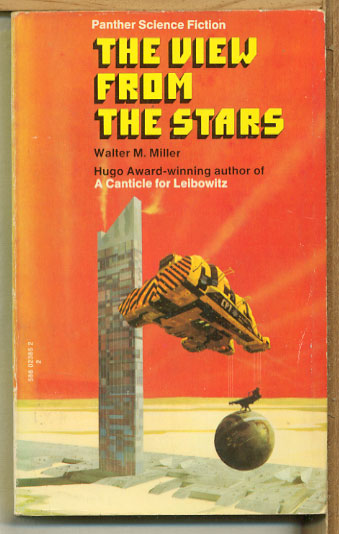
author:
title:
Miller, Walter M. Jr.
THE VIEW FROM THE STARS
book-date: 1965
edn-date:
printing:
format:
cvr art:
cvr price:
GRADING:
1973
Paperback
Chris Foss
35pence
VG+
This cover has also been used on the July 1973 Ace paperback of Ten Thousand Light-Years From Home by James Tiptree, Jr.
You Triflin' Skunk! - (original title: "The Triflin' Man")
The Will
Anybody Else Like Me? - (original title: "Command Performance")
Crucifixus Etiam
I, Dreamer
Dumb Waiter
Blood Bank
Big Joe and the Nth Generation - (original title: "It Takes A Thief")
The Big Hunger
His second collection of stories (1965.) Original appearances from 1952 to 1955: in Fantastic Universe, Astounding, Amazing, Galazy, Fantasitc, IF.
For plot summaries, I quote from P. Schuyler Miller's review in Analog (June 1967):
"Four of the stories originated here when Analog was Astounding Science Fiction, in 1952 and 1953. All four have been in anthologies.
The best - and best-known - is "Crucifixus Etiam," which you may recall as a pitilessly realistic story of a laborer on Mars, and artificial lung built into his body, as he gradually comes to the realization he can never live anywhere else, nor ever see the pleasanter world he is building…
"Blood Bank" is even grimmer in its basic idea - one that can't be explained without giving away the answer to the puzzle its hero is trying to solve. He has fired on a mercy ship from Earth, carrying surgical spare parts to a world in trouble, and must justify himself in his own eyes. Apart from the puzzle, the glimpses of radically different cultural values on different worlds is a vigorous and effective anticipation of what Cordwainer Smith is doing today.
"Dumb Waiter," the third from Astounding, is almost a stereotype of an ASF story of that period. A computer-run city is trying to carry on business as usual, though its human population is dead or has fled a nuclear dusting. But there is nobody to change its programming to match the new situation. How to do it, and make the automatic city again serve man, is the hero's problem.
Number Four, "The Big Hunger," is a pretty slight filler on the question: "Why do men go to the stars?"
Of the other stories, "Big Joe and the Nth Generation" is another problem story, harsh and ingenious. It could even depict a Mars that has briefly reached the condition that was being created in "Crucifixus Etiam," then slipped back into barbarism. A young thief finds a way past the savage robot protector of the nuclear installation that will restore the planet's vanishing atmosphere, and starts his world on the way back to rational civilization.
"You Triflin' Skunk!" is the story of The Midwich Cuckoos told earlier and in a different way. The "man" from space has impregnated one Southern cracker-woman rather than a whole village, but his purpose is not very different. What is different is what she does and how she does it when he returns to claim his son.
"The Will," on the other hand, is slight and sentimental and totally unlike the tough plots I have described. An incurably sick child finds a way save himself when present-day science gives up. "Anybody Else Like Me?" offers a black variation on the story of the telepaths who discover each other. And "I, Dreamer" is an early story of the philosphical and psychological problems of what are now call cyborgs -robots controlled by human brains built into them as part of their mechanism. Why did these stories have to wait fourteen years to be collected?"